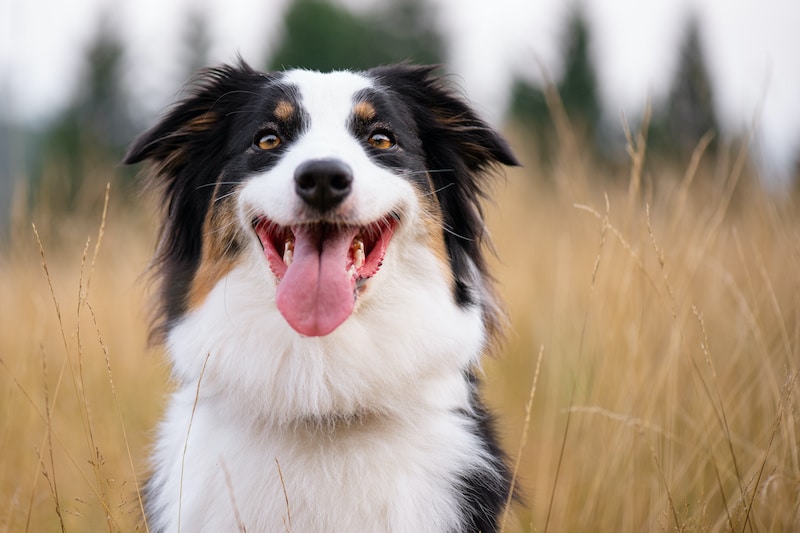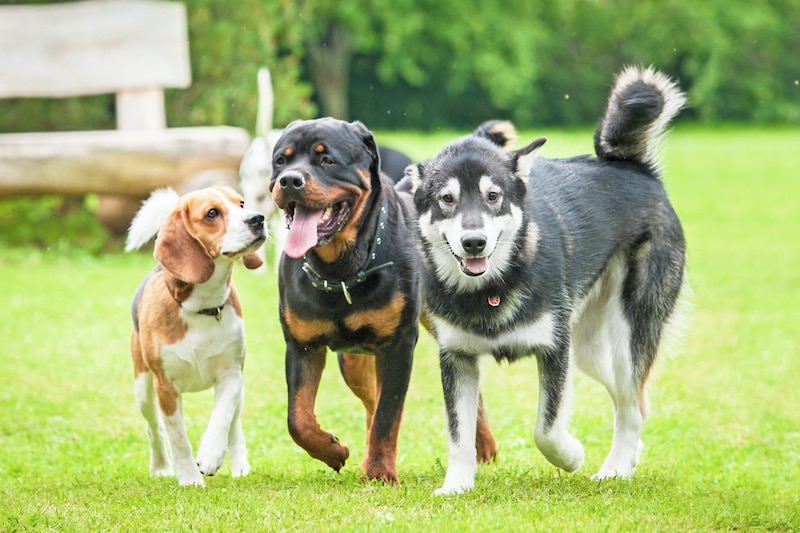Australian Shepherds (Aussies) are working dogs with European, Australian, and American heritage, all rolled into one. They’re smart, energetic, loyal, and love keeping you on your toes.
How much do they shed?
The Australian Shepherd is an average shedding breed that, given its double coat, tends to shed more during seasonal changes like spring and fall.
They’re fairly low maintenance with respect to grooming but should be brushed regularly to keep their coat in good shape and reduce shedding.
In this article, we’ll be taking a closer look at how Aussies shed, what they’re like to groom, and what makes them such a special breed!
Australian Shepherd Shedding
Australian Shepherds are an average shedding breed.
So you will notice some hair floating around your home, but it’s not excessive and easy enough to keep under control with regular brushing.
However, they are double coated, which means they have a top coat of hair as well as a thick, furry undercoat that keeps them well insulated from hot and cold conditions.
As such, they do shed more during seasonal changes like spring and fall when they’re either shedding their winter coat or developing a new one.
So this is when you’ll typically notice excessive shedding. Which is a similar story to their closely related Border Collie, and even totally unrelated breeds with a double coat like the Bernese Mountain Dog for example.
Some Aussie owners choose to shave the undercoat, but this generally isn’t a good idea because their undercoat is what helps protect your Aussie from extreme weather conditions, hot or cold.
It’s normal for Aussies to shed, or most dogs for that matter, so this isn’t something you should try to stop, nor can you. Even shaved they will still shed, the hairs will just be smaller and less noticeable.
Thankfully though, it is something you can keep under control with a regular brushing routine. And in the next section we’ll take a closer look at how to approach this.
What Are Aussie’s Like to Groom?
Australian Shepherds have a medium to long double coat that can be either black, red, merle or blue merle in color, with white and tan markings.
They are relatively easy to groom, but because they have a longer and somewhat wavy top coat, and are rugged dogs that love being outside, they are prone to matts and tangles.
So it’s important to brush them regularly to keep their coat matt free and in the best shape possible, which not only helps them feel more comfortable and look better, but when their coat is in good shape it serves them better during extreme weather conditions.
Brushing is also important to brush from a shedding perspective. In fact, it’s probably your best defence against having a home full of dead hairs.
This is because brushing helps remove the dead hairs, which keeps it off your floors and furniture, and helps to evenly distribute his coat oils, which in turn helps keep shedding lower than if he had dry skin.
In terms of brushing frequency, it’s generally best to brush at least a 2-3 times per week, and more during periods of excess shedding like spring and autumn, as his coat prepares for a change in weather.
The best type of brush to use is a slicker brush in conjunction with an undercoat rake or deshedding tool.
Start by brushing their coat with in the direction of the fur with a slicker. This will allow you to remove the bulk of dead hairs, matts and knots from the top coat.
Then, use an undercoat rake or deshedder to remove the loose fur from the undercoat, which is soft and thick. If you encounter any matts, it’s best to use your hands or the slicker brush to gently remove these, then continue on.
Deshedding tools are typically best during times of heavy shedding, and not much more expensive than a rake, but in the end it comes down to preference and what works best for you.
Are Australian Shepherds Hypoallergenic?
No, Aussies are not a hypoallergenic breed. So if you have allergies to dogs then this may not be the best breed for you.
The reality is that no dog is ever truly hypoallergenic though, it’s just that some breeds are better than others, and typically those that shed less hair.
This is because the allergens actually come from the dander and dry saliva of the dog, which attach themselves to the dogs hair. And when that hair makes its way around the home, the sneezing begins.
A better breed for allergy suffers would be one like a Basenji or Wheaten Terrier, because both of these breeds shed a lot less than an Aussie Shepherd.
Recommended: Go here to see our top-rated dog hair blow dryers
How to Reduce Excessive Shedding
The best way to reduce the amount of hair your Aussie leaves around your home, and everywhere else for that matter, is to brush regularly. Brushing is one of the best ways to defend against unwanted hair loss for two reasons.
First because you are literally removing the hair from your dog’s coat before it has a chance to fall out. So a regular brush, even once per day when they are blowing coat (seasonal shedding) is going to significantly reduce this problem.
The second reason brushing helps is because it helps maintain your dog’s coat, by spreading the oils of the coat evenly over his skin. Which naturally helps to protect against dry, irritated skin. A leading cause of excessive shedding.
Aside from this, there are some things you can do (and avoid doing) that can help keep shedding to a minimum. Such as:
- Avoid over bathing as this can dry out your Aussie’s skin, and when you do bath, use a high quality dog shampoo.
- Feed him a well balanced, quality dog food that is rich in vitamins, minerals and omega 3 fatty acids such as Tuna, Salmon and Flaxseed.
- Try a home remedy like coconut oil or olive oil during periods of high shedding which, in moderation, can help improve the moisture content in the coat.
You can learn more about how to reduce shedding here.
Recommended: Go here to see our top-rated dog hair blow dryers
Should You Adopt an Aussie?
Aussies are a highly intelligent breed that love both mental and physical stimulation. So they’re best suited to someone with enough land to let them run free, and who has time to play.
They are very loyal, to the point they’re known as “velcro dogs”. Once they form an attachment with you, they bond for life and won’t leave your side. So they make excellent companions and family members.
They’re also good with other dogs and children.
However, they are a dominant breed by nature, and when it comes to kids, can treat them like part of the flock and try to herd them (lol). This is because they are a herding dog.
So they might nip at their feet and so forth at first, as they naturally would when herding, but they are highly trainable and obedient dogs, so with proper training, this shouldn’t be a problem.
Their intelligence, trainability, and agility also make them good watchdogs and even service dogs. Which is why they are often used in search and rescue efforts, detection, and guide dogs.
So they are extraordinary dogs but probably not suited to apartment living given they bark a lot and need lots of stimulation. And they may not be best for those looking for a low maintenance, low shedding breed either.
In that case, you may be more interested in a smaller dog that sheds less, but that is also highly intelligent and trainable, like the dogs we discuss in this post.
What’s Their Heritage?
There’s a lot of debate as to exactly what breeds make up the Australian Shepherd and exactly where they come from. However, one thing is clear, they’ve done quite the world tour!
Aussies are said to have originated in Europe near the Pyrenees Mountains, with the Pyrenean Shepherd being their earliest ancestor. From here, they traveled to Australia with the indigenous Basques people as it was favorable to sheep herders at the time.
It was at this time where they were said to have cross bred with local and imported breeds, like the Collie. But even though there are many similarities between the Border Collie and Aussie Shepherd, it is unclear if they were actually cross-bred.
In any case, from Australia, a relatively small group of Basques set sail for California in search of greener pastures in the 19th century, and the breed was further developed from there. And in 1993, the Aussie became an official American Kennel Club breed standard.













Please note: By submitting a comment using the above comment form, you confirm that you agree with the storage and handling of your data by this site as detailed in our Privacy Policy.